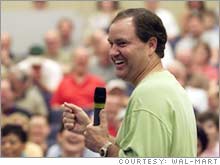|
Wal-Mart CEO trumpets change
Lee Scott tells reporters the company is in 'transformation'; he outlines growth plans, intentions to retail more fashionable clothes, and responds to critics.
ROGERS, Ark. (CNNMoney.com) - Speaking to reporters Wednesday, Wal-Mart CEO Lee Scott was unequivocal that he's pushing hard for change - in merchandise, marketing, global sourcing, health-care policies, and more. "What is going on at Wal-Mart these days cannot be denied. Wal-Mart is a company in transformation," Scott said during his presentation at Wal-Mart's second annual media conference. "And it has meaning...real meaning. It means real changes that improve the lives of real people and get great results for our company."
This focus on change comes at a time when Wal-Mart is being challenged to compete more aggressively while still remaining relevant to customers in a rapidly diversifying marketplace. Citing Wal-Mart's record $315 billion in annual sales last year, Scott said the company was approaching change from a "position of strength." But some industry watchers maintain that the world's largest retailer has little choice but to look for new ways to expand the business at a time when both its sales and profit growth has slowed in its largest domestic market. To that point, Scott indicated that he was a "little bit concerned" that high gas prices could dampen sales this year. "We have to be careful. We are still looking for a stable year," he said. Growth plans
"We're growing robustly abroad," Scott said. "Our international sales were up double-digits in 2005. We expanded our presence from 11 countries to 16 countries." "Today Wal-Mart is a larger company and a more profitable company. But more importantly...we are transforming ourselves to be better for our communities, better for our customers and better for associates." Earlier in the day, Wal-Mart's Chief Financial Officer Tom Schoewe said the company was committed to its 8% domestic growth in square footage for the year. Wal-Mart said it would open between 335 and 370 new stores in the U.S. and between 220 and 230 new stores internationally. "This expansion is negative to our return on investment but the new stores will add to sales and earnings in years to come," said Schoewe. Wal-Mart is also scouting the globe for acquisitions, which he said should help improve overall sales but will temporarily hurt assets. Schoewe acknowledged that Wal-Mart is sometimes cannibalizing itself by opening new stores close to existing stores, but said, "our total sales will increase and that translates into market-share growth when compared to our competition." Schoewe also touched on Wal-Mart's plans to reduce inventory this year as it strives to cut costs. "Our aim is to grow inventory at half the rate of sales growth. Over the last six quarters, we haven't met that objective." Turning fashionable?
Apparel historically has been one of Wal-Mart's weakest performing categories since the low-cost discounter has focused more on selling cheap clothing versus "fashionable" wear. Wal-Mart is changing that approach, Scott said. "One of the ways that we are working to strengthen the customer experience is to broaden the appeal of our merchandise. This requires a delicate touch," he said. "We are offering more fashion-forward merchandise," citing the retailer's trendy private label Metro 7 collection for women and the new "Exsto" urban wear for men expected to debut this year. Wal-Mart also is launching a new line of organic baby clothes this year. "We want to keep our most loyal customers coming to our stores for their everyday needs but we also want them to buy merchandise they may not typically pick up at Wal-Mart and we want to attract new customers who may not typically shop at Wal-Mart," he said. Scott also identified the Hispanic community as a key growth opportunity for Wal-Mart, adding that the company was spending $45 million a year in Spanish-language advertising and building marketing events around events like World Cup soccer. "Right now Hispanics have a greater affinity for Wal-Mart than any identifiable segment of the U.S. population," he said. Hispanic consumers are projected to hold about 10 percent, or $1 trillion, of U.S. consumers' buying power by 2010 and Wal-Mart is well-positioned to "capture a significant portion of this market," he said. Health care's a difficult challenge
Wal-Mart's wages, benefits and hiring policies are the three areas where it faces the most aggressive backlash from its critics, including union-funded watchdog groups Wake-Up Wal-Mart and Wal-Mart Watch. Detractors allege that the company shortchanges its workers by providing them with inadequate health-care coverage because it wants to keep its costs down. Under pressure from critics, the company earlier this week announced that it was tweaking its health-care plans to better benefit its associates. The new steps include halving the waiting period to one year for part-time employees and reducing employee co-payments for certain prescription drugs to $3 from $10. Scott acknowledged that health care was on top of "everyone's list." Still, he said, solving the national health-care crisis was not just Wal-Mart's responsibility but that of the government, businesses, labor unions and of individual Americans. "At Wal-Mart we are determined to do our part and lead," Scott said. Scott's message to the union-funded groups was that they should talk to the 130 million customers who shop Wal-Mart stores every week. "Look them in the eyes and ask them if what Wal-Mart does for their lives and their communities is a publicity stunt. They will tell you Wal-Mart is real. They will tell you in one word, Wal-Mart means opportunity." ------------------------------------------------- Wal-Mart: One size may not fit all.
Wal-Mart falls to No. 2 on the Fortune 500 list this year. Who's No. 1? See the list. |
|

